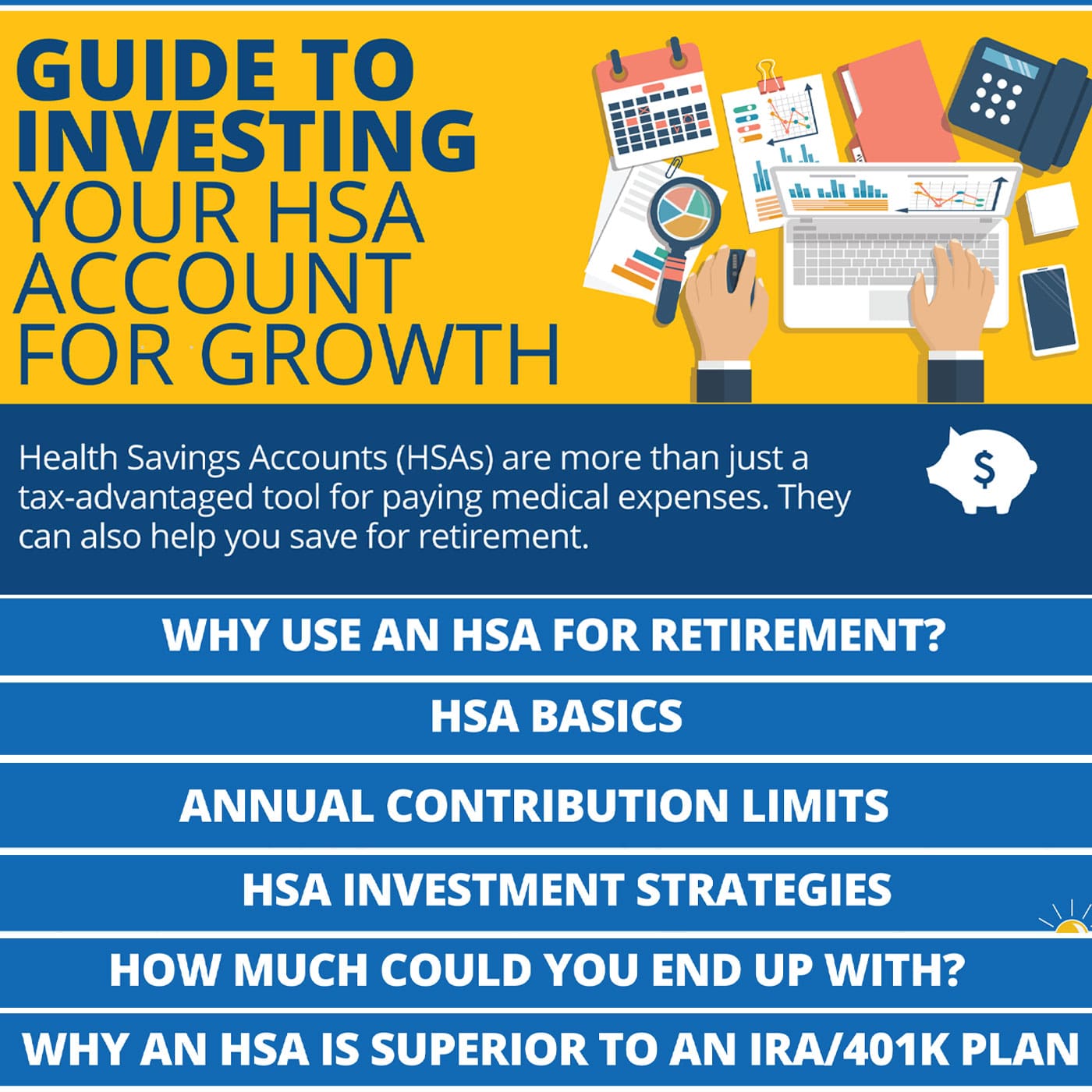The following infographic, “A Guide to Investing Your HSA Account for Growth”, provides an overview of Health Savings Account (HSA) basics.
Read below to find out why HSAs are a great option for retirement, investment strategies, and more.

Guide To Investing Your HSA Account for Growth
Health Savings Accounts (HSAs) are more than just a tax-advantaged tool for paying medical expenses. They can also help you save for retirement.
Why include HSAs in retirement planning?
HSAs offer a triple tax advantage:
- All contributions to your HSA account are tax-deductible
- All funds in your account grow tax-free – including interest, dividends, or capital gains
- Withdrawals that pay for qualified medical expenses are tax-free
- HSA funds can be invested similarly to those in a 401k or IRA account
Let’s start with the basics.
- Withdrawals that pay for qualified medical expenses are always tax-free, regardless of your age
- You must be enrolled in an HDHP to contribute and may not be on Medicare
- After age 65, you can use withdrawals for any expense, although they will be taxed at your standard rate
- You own your HSA account and take it when you change jobs or retire
HSA Contribution Limits
- Contribution limits for 2024
- Self: $4,150
- Family: $8,300
- Contribution limits for 2025
- Self: $4,300
- Family: $8,550
- “Catch-up” contributions (age 55 or older): $1,000 in addition to the above amounts
HSA Investment Strategies
- Treat your HSA like an investment account. Don’t spend the funds unless you need them for medical expenses
- Max out your investment by making the maximum annual contribution each year (including the extra $1,000 catch-up after age 55)
- Take full advantage of any employer-matching contributions
- Invest unspent funds wisely, using sound diversification and risk strategies
How Large Could Your Account Grow?
With maximum annual contributions and minimal medical expense withdrawals, you can build a hefty nest egg to complement your regular retirement plan.
Assume the following parameters:
- You start your HSA account at age 26
- You make the maximum family coverage contribution every year until age 65, including catch-up contributions
- You earn an average annual return of 8% by investing in the stock market
- You do not withdraw funds for medical expenses
- You pay no fees for your plan
When you retire at age 65, your HSA may be worth more than $1.9 million!
Even if you only contribute $3,000 a year for 20 years, don’t withdraw any funds, and the money grows at 8%, you will still end up with about $143,000 – an excellent addition to anyone’s nest egg.
(Calculations via Fidelity Bank’s HSA Calculator)
Is an HSA superior to an IRA/401k plan?
- Once you withdraw funds from a 401k or IRA, you pay income tax regardless of how the funds are spent.
- Unlike 401(k)s, or IRAs, an HSA does not require you to begin making withdrawals at a certain age.
- The funds can stay in your HSA account (earning interest or investment income) as long as you want.
For 40 years, DataPath has been a pivotal force in the employee benefits, financial services, and insurance industries. The company’s flagship DataPath Summit platform offers an integrated solution for managing CDH, HSA, Well-Being, COBRA, and Billing. Through its partnership with Accelergent Growth Solutions, DataPath also offers expert BPO services, automation, outsourced customer service, and award-winning marketing services.

